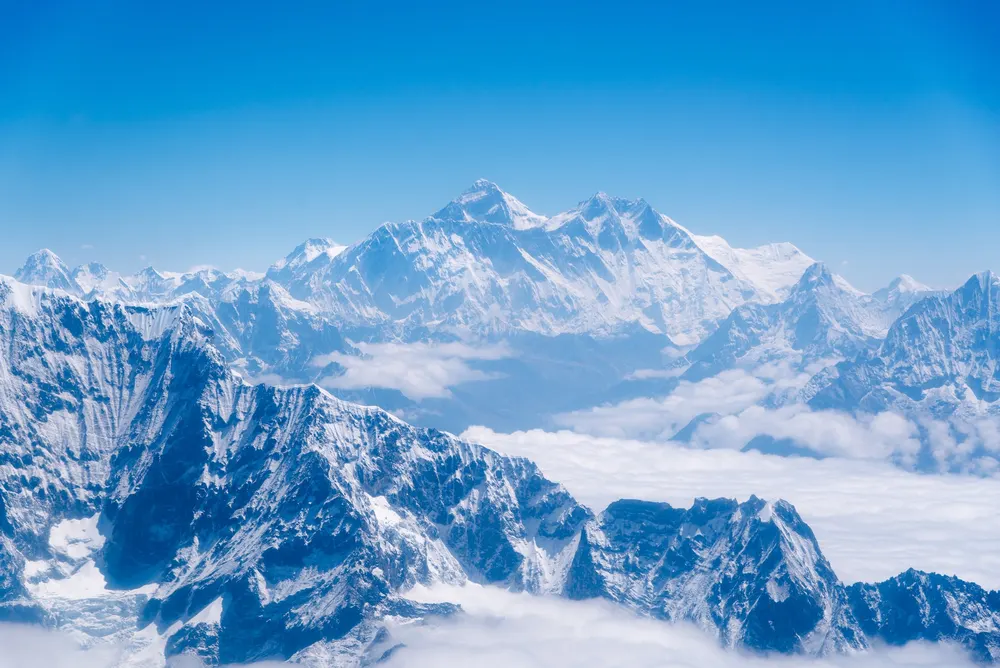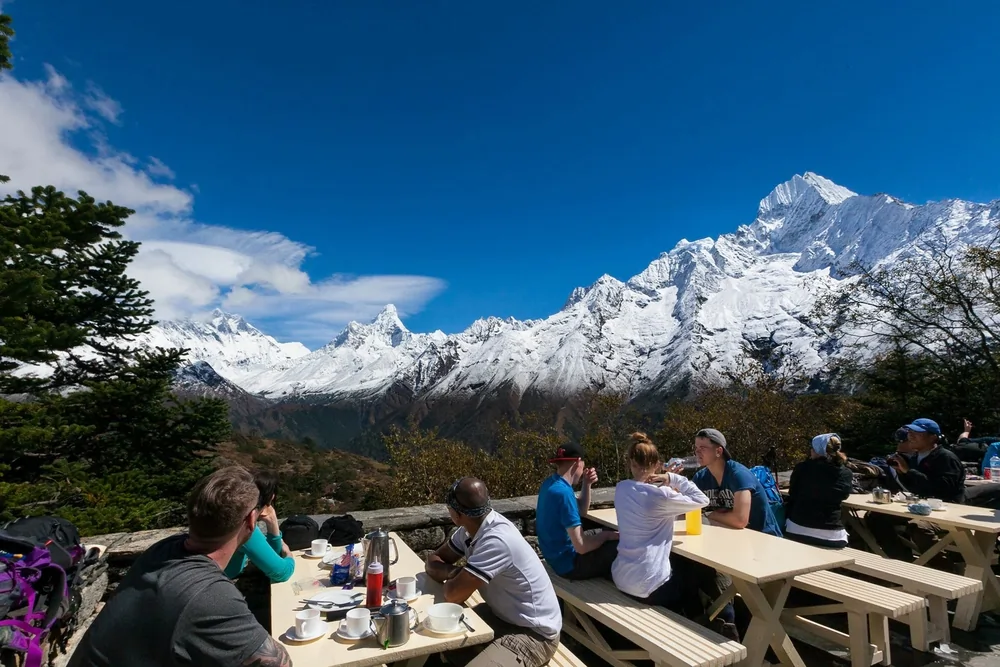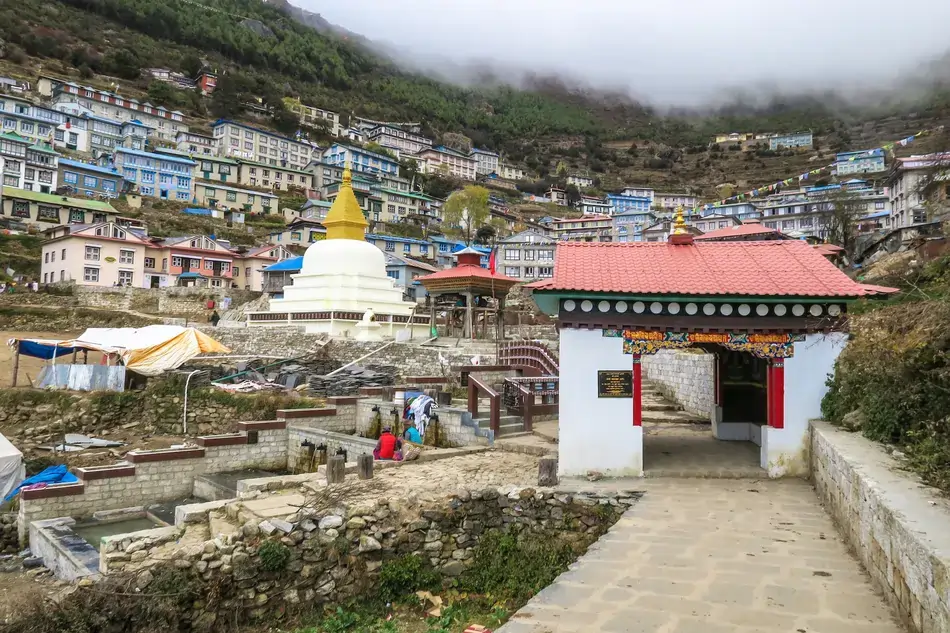Overview
The accommodations offer amenities such as spacious rooms, comfortable beds, hot showers, heating systems, and meals prepared by skilled chefs. This luxury trek follows the trekking route for the Everest Base Camp trek, taking you all the way up to Namche, which offers stunning landscapes, dense forests, and breathtaking mountain views along the way.
We will spend a day in Namche for acclimatization, so you will also have the chance to fully experience the distinctive local culture of the Sherpas. The Sherpa people are renowned for their warm hospitality and adept mountaineering. You can interact with the people, visit monasteries, and discover more about their history, way of life, and conventional religion. You can also choose to take an optional helicopter ride from Namche to the 5455-meter-high Kalapatthar viewpoint, which offers up-close views of Mount Everest.
Throughout the trek, you will be accompanied by professional guides and support staff ensuring your safety and offering insights into the ecology, history, and culture of the area. Your luggage may be carried by porters or yaks, which will give you an option to hike with a smaller daypack.
Trip Highlights
- Stay in high-end luxury accommodations amongst the Himalayas(Yeti Mountain Home and Summit lodges)
- Witness scenic Mountain Landscapes of Everest, Lhotse, Nuptse, Ama Dablam, and many other notable peaks
- Immerse yourself in the unique Sherpa culture and their hospitality and get to know their way of living
- Go on an optional side trip to the KalaPatthar viewpoint standing at a grand 5,455m
Trip Itinerary
- Cross the thrilling suspension bridge over Dudh Koshi River
- Walk past well-decorated mani-walls and chortens
- Close-up view of Ama Dablam — considered the most beautiful mountain in the world
- Breathtaking view of Ama Dablam, Taboche, and Cholatse
- Close-up view of Nuptse and Taboche
- Look over the marvelous Khumbu Glacier
- Excursion to the Everest Base Camp
- Opportunity to stand at the shore of the world’s highest mountain
- Close-up view of Nuptse, Pumori, Khumbu Icefall, and Khumbutse.
- Incredible flight from Lukla to Kathmandu
- Enjoy the breathtaking sight of the mountains and surrounding landscapes
- Farewell dinner in the evening
Services
Services Included in the Package
- Pick up/drop off from airport
- Two Nights Luxury Accommodation in Kathmandu with Breakfast
- Lukla flights Round Trip
- Upgraded Lodge Accommodation
- Hot Shower during trekking
- Meals( Breakfast, Lunch & Dinner) during trek
- A professional guide
- A Porter Between Two Trekkers
- Tims Trekking permit
- Sagarmatha National park permit
- Helicopter Return from Goraksep to Lukla
- Farewell Dinner
Services Excluded in the Package
- Additional Accommodation in Kathmandu (More than two nights)
- Lunch and dinner in Kathmandu
- All bar bills
- Personal expenses
- Tips and Donations
- Laundry Service/WIFI
- Electronic devices recharging
- Emergency Evacuation
- Travel/Medical Insurance
More Info
Our guides
Experience Everest like never before with our Sherpa Trekking Guide, a seasoned expert with extensive guide training, unmatched experience, and first-aid proficiency. Our guides, deeply rooted in Himalayan culture, provide not just a journey but an education. Benefit from their in-depth knowledge of the region, safety protocols, and local customs. With first-aid skills, they prioritize your well-being in the high-altitude environment. Navigate challenging terrain with confidence and immerse yourself in the Sherpa way of life. This guide isn’t just about reaching Everest’s summit; it’s about gaining a profound understanding of the world’s tallest peaks, making your trek a safe, memorable, and culturally rich adventure
Accommodations during trek
Experience a new level of comfort in the heart of the Himalayas with our upgraded accommodation options for Everest trekking. Enhance your journey by staying in well-appointed lodges and teahouses, carefully selected for their modern amenities and cozy ambiance. Enjoy warm, comfortable beds, clean and hygienic facilities, and even hot showers in some places. Immerse yourself in the local culture while indulging in better sleep quality and relaxation after a day of trekking. Our upgraded accommodation ensures that your Everest adventure is not only about conquering the trails but also about enjoying a touch of luxury amid the world’s most majestic mountain scenery.
High altitudes during trek
High Altitude Sickness, or Acute Mountain Sickness (AMS), can affect trekkers at higher elevations. Symptoms include headache, nausea, dizziness, and fatigue. To prevent AMS, acclimatize by ascending gradually, stay hydrated, and avoid alcohol. Descend if symptoms worsen. Treatment includes rest, hydration, and over-the-counter medications. Severe cases, like High Altitude Pulmonary Edema (HAPE) or High Altitude Cerebral Edema (HACE), require immediate descent and medical attention. Oxygen therapy and medication can help. Evacuation may be necessary in critical conditions, often facilitated by local rescue teams or helicopters. Awareness, preparation, and early recognition of symptoms are vital for a safe high-altitude trek.
Permit and Entry fees
To trek in the Everest region, you’ll need two permits: the Sagarmatha National Park Permit and the Khumbu Pasang Lhamu Rural Municipality Entry Permit. The combined cost is around $50. Prices may change, and it’s essential to check with local authorities or a travel agency for the most up-to-date information on permits and fees.
Is travel Insurance necessary for this trek?
Travel insurance is essential for Everest trekking due to the unpredictable and challenging nature of the environment. It provides coverage for emergency medical evacuation in case of altitude sickness or injury, which can be costly. It also safeguards against trip cancellations, delays, lost baggage, and other unexpected events. Given the remote and high-altitude conditions in the Everest region, travel insurance offers peace of mind and financial protection, ensuring you receive proper care and support in emergencies.
Recommended Trekking Equipments
Clothing:
Moisture-wicking base layers: To keep you dry and regulate body temperature.
Insulating layers: Fleece or down jackets for warmth.
Waterproof and windproof outer shell: Gore-Tex or similar material.
Trekking pants and shorts: Quick-drying and breathable.
Warm hat and gloves: To protect against the cold.
Socks: Wool or synthetic hiking socks for moisture control.
Gaiters: To keep snow, rocks, and debris out of your boots.
Footwear:
Sturdy and comfortable trekking boots with ankle support.
Gaiters to keep your feet dry and debris out of your boots.
Extra laces and insoles.
Backpack:
A comfortable, durable backpack with a rain cover.
Daypack: A smaller pack for daily essentials during treks.
Sleeping Gear:
Sleeping bag rated for cold weather.
Sleeping pad or insulated mat for insulation and comfort.
Trekking Poles:
Adjustable trekking poles to assist with balance and reduce strain on your knees.
Headlamp/Flashlight:
With extra batteries.
Water Purification:
Water purification tablets or a water filter to treat water from streams and rivers.
First Aid Kit:
Including medications for altitude sickness, pain relief, and common ailments.
Sun Protection:
Sunglasses with UV protection.
Sunscreen with high SPF.
Lip balm with SPF.
Trekking Accessories:
Buff or neck gaiter for protection against cold and dust.
Bandana or handkerchief.
Watch with altimeter, barometer, and compass.
Whistle.
Pocket knife or multitool.
Climbing Gear (if doing a more advanced trek):
Crampons.
Ice axe.
Harness.
Carabiners and ropes.
Electronics:
Camera and extra batteries.
Power bank and charging cables.
International power adapter.
Toiletries:
Travel-sized toiletries.
Biodegradable soap.
Toilet paper and a small trowel (for wilderness sanitation).
Documents:
Passport with Nepal visa.
Trekking permits and necessary paperwork.
Photocopies of important documents.
Emergency contact information.
Cash:
Nepali Rupees in small denominations
Map
FAQs
The Luxury Everest Trek requires a good level of fitness as it involves trekking through varied terrain and ascending to high altitudes. Regular exercise, including cardiovascular activities and strength training, is recommended prior to the trek. Consult with your doctor before undertaking any strenuous physical activity.
Altitude sickness can affect trekkers at higher altitudes. However, the Luxury Everest Trek is designed with acclimatization days and a gradual ascent to help minimize the risk. Our experienced guides closely monitor the group’s health and provide necessary guidance and support throughout the trek.
The Luxury Everest Trek offers a wide range of high-quality meals prepared by expert chefs. You can expect a combination of local Nepali cuisine and international dishes. Vegetarian and special dietary requirements can be accommodated, but it’s important to inform the organizers in advance.
While most luxury lodges and tea houses along the trek route offer Wi-Fi facilities, it is important to note that the availability and reliability of internet connections may vary. There may be an extra charge for Wi-Fi usage in some accommodations.










